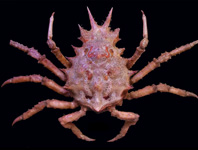Abstract
Polyplocia nebulosa sp. nov. is described based on male and female imagos from Malaysia, Sabah State. Nymphs provisionally assigned to this species are also described. This species can be readily separated from P. vitalisi by the color pattern of the wings, with light brown longitudinal veins, narrow dark brown clouds on cross veins and margins of wings tinged with brown. The male genitalia are distinct from those of other species of Polyplocia: penes are broad, T-shaped, with large lateral projecting lobes, which are apically rounded, and with a small dorsolateral spine on each lobe; the styliger plate is short and not projected posteriorly. Eggs of the genus are described for the first time using scanning electron microscopy. Eggs are 265–267 µm in length, 170–186 µm in width, barrel-shaped, without polar caps or other attachment structures, with one visible micropyle and with chorion forming an irregular mesh with raised ridges (mesh between 3.8–8 µm). A key to male adults of Polyplocia is provided and additional records of Polyplocia from Thailand are given.
References
Demoulin, G. (1952) Contribution à l'étude des Ephoronidae Euthyplociinae (Insectes Éphéméroptères). Bulletin de l'Institut Royale des Sciences Naturelles de Belgique, 28 (45), 1–22.
Demoulin, G. (1953) A propos des Polyplocia de Borneo (Insectes Éphéméroptères). Bulletin de l'Institut Royal des Sciences Naturelles de Belgique, 29 (19), 1–4.
Demoulin, G. (1958) Nouveau schéma de classification des Archodonates et des Éphéméroptères. Bulletin de l'Institut Royal des Sciences Naturelles de Belgique, 34 (27), 1–19.
Demoulin, G. (1966a) Contribution à l'étude des Euthyplociidae. III. (Insectes Éphéméroptères). Zoologische Mededelingen, 41 (7), 137–141.
Demoulin, G. (1966b) Contribution à l'étude des Euthyplociidae [Ephemeroptera]. IV. Un nouveau genre de Madagascar. Annales de la Société Entomologique de France, 2 (4), 941–949.
Eaton, A.E. (1871) A monograph on the Ephemeridae. Transactions of the Entomological Society of London, 1871, 1–164.
Edmunds, G.F. & Traver, J.R. (1954) An outline of a reclassification of the Ephemeroptera. Proceedings of the Entomological Society of Washington, 56, 236–240.
Gillies, M.T. (1980) The African Euthyplociidae (Ephemeroptera) (Exeuthyplociinae subfam. n.). Aquatic Insects, 2 (4), 217–224.
http://dx.doi.org/10.1080/01650428009361032Kluge, N. (2004) The Phylogenetic System of Ephemeroptera. Kluwer Academic Publishers, Dordrecht, 442 pp.
http://dx.doi.org/10.1007/978-94-007-0872-3Koss, R.W. & Edmunds, G.F. (1974) Ephemeroptera eggs and their contribution to phylogenetic studies of the order. Zoological Journal of the Linnean Society, 55, 267-–349.
http://dx.doi.org/10.1111/j.1096-3642.1974.tb01648.xLestage, J.A. (1921) Les Éphémères indo-chinoises. Annales de la Société Entomologique de Belgique, 61, 211–222.
Lestage, J.A. (1924) Faune entomologique de l'Indochine française. Les Éphémères de l'Indochine Française. Opuscules de l'Institut Scientifique de l'Indochine, 3, 79–93.
McCafferty, W.P. (1991) Toward a phylogenetic classification of the Ephemeroptera (Insecta): A commentary on systematics. Annals of the Entomological Society of America, 84 (4), 343–360.
http://dx.doi.org/10.1093/aesa/84.4.343McCafferty, W.P. (2004) Higher classification of the burrowing mayflies (Ephemeroptera: Scapphodonta). Entomological News, 115 (2), 84–92.
Needham, J.G. & Murphy, H.E. (1924) Neotropical mayflies. Bulletin of the Lloyd Library, Number 24, Entomological Series, 4, 1–79.
Nguyen, V.V. & Bae, Y.J. (2003) A new euthyplociid burrowing mayfly (Ephemeroptera: Euthyplociinae, Polymitarcyidae) from Vietnam. Korean Journal of Biological Sciences, 7, 279–282.
http://dx.doi.org/10.1080/12265071.2003.9647716
Ulmer, G. (1939–1940) Eintagsfliegen (Ephemeropteren) von den Sunda-Inseln. Archiv für Hydrobiologie, 16 (Supplement), 443–692.

